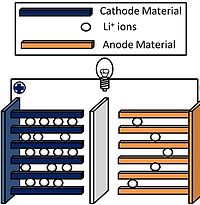
Photo from wikipedia
Abstract Lithium-rich layered compound cathode materials recently attract ever-growing attention in lithium ion batteries for electric vehicles and energy storage devices due to their high discharge capacities of over 250 mAh g… Click to show full abstract
Abstract Lithium-rich layered compound cathode materials recently attract ever-growing attention in lithium ion batteries for electric vehicles and energy storage devices due to their high discharge capacities of over 250 mAh g −1 and low cost. However, they still suffer from capacity fade, voltage decay and poor rate capability and thermal stability. In this paper, the Al&F co-doped Li 1.2 Ni 0.13 Co 0.13- x Mn 0.54 Al x O 2(1- y ) F 2 y cathode material has been successfully prepared via a co-precipitation reaction and a subsequent solid phase calcination. The resulting material combines the advantages of both Al-doping and F-doping, which can effectively mitigate the intrinsic layered-to-spinel phase transformation, and as a consequence, inhibits the capacity fade and voltage decay: delivering a discharge capacity of 217 mAh g −1 with retention of 88.21% and an average discharge voltage decay of 0.4019 V upon 150 cycling at 0.5 C. On the other side, with an increased electronic and ionic conductivity, this co-doping practice enhances the rate capability by a considerable extent that it delivers a discharge capacity of 157 mAh g −1 at 10 C, thus facilitating its application for quick charging devices. In addition, the thermal stability related with battery safety is significantly meliorated. Specifically, the co-doped cathode material exhibits an initial exothermal peak at a higher temperature of 273 °C and a much less overall heat generation of 221 J g −1 compared to the 210 °C and 755 J g −1 for the pristine one. In conclusion, the anion/cation co-substitution strategy has been demonstrated to be of great promise for the improvement of lithium-rich layered cathode materials.
Journal Title: Electrochimica Acta
Year Published: 2017
Link to full text (if available)
Share on Social Media: Sign Up to like & get
recommendations!